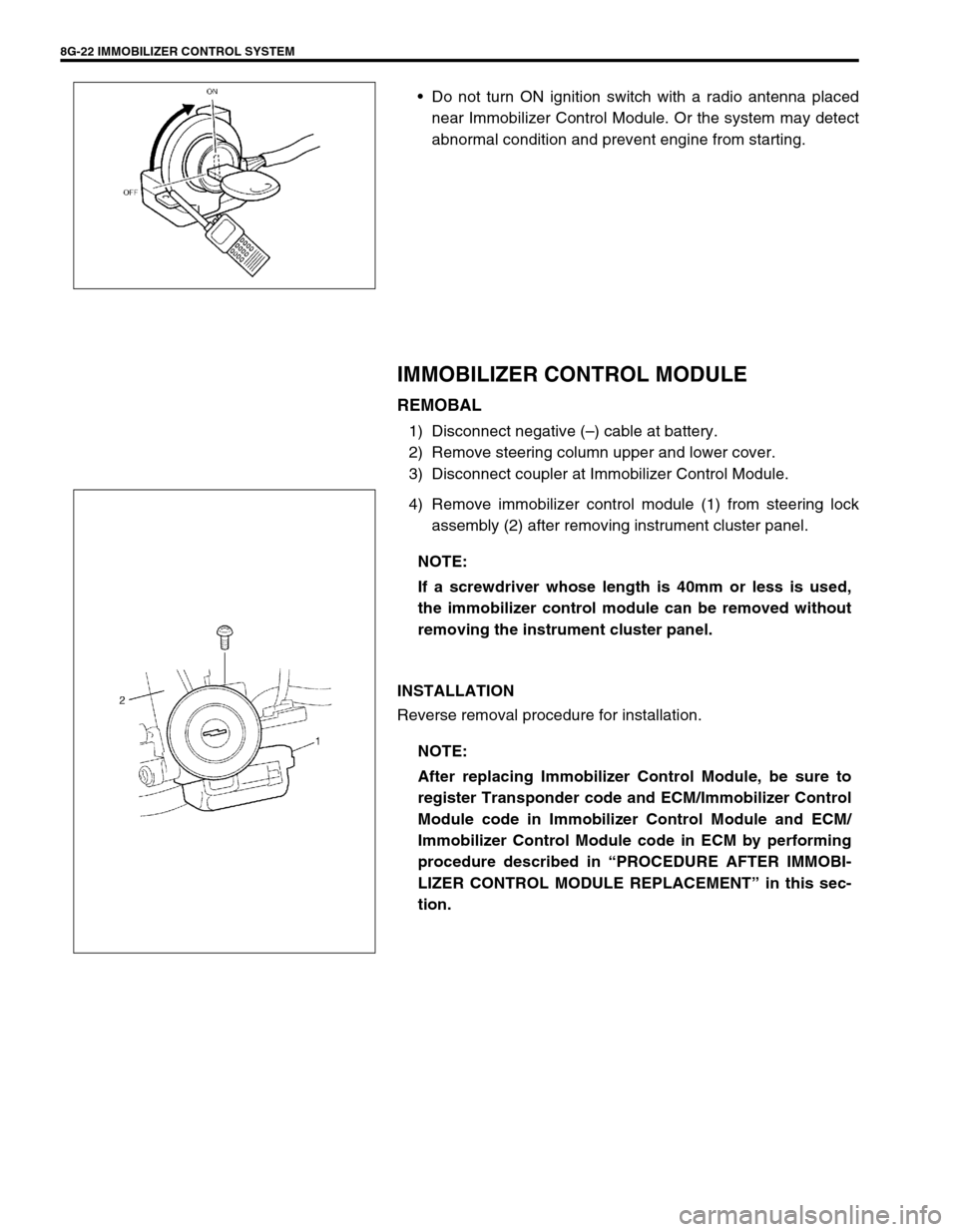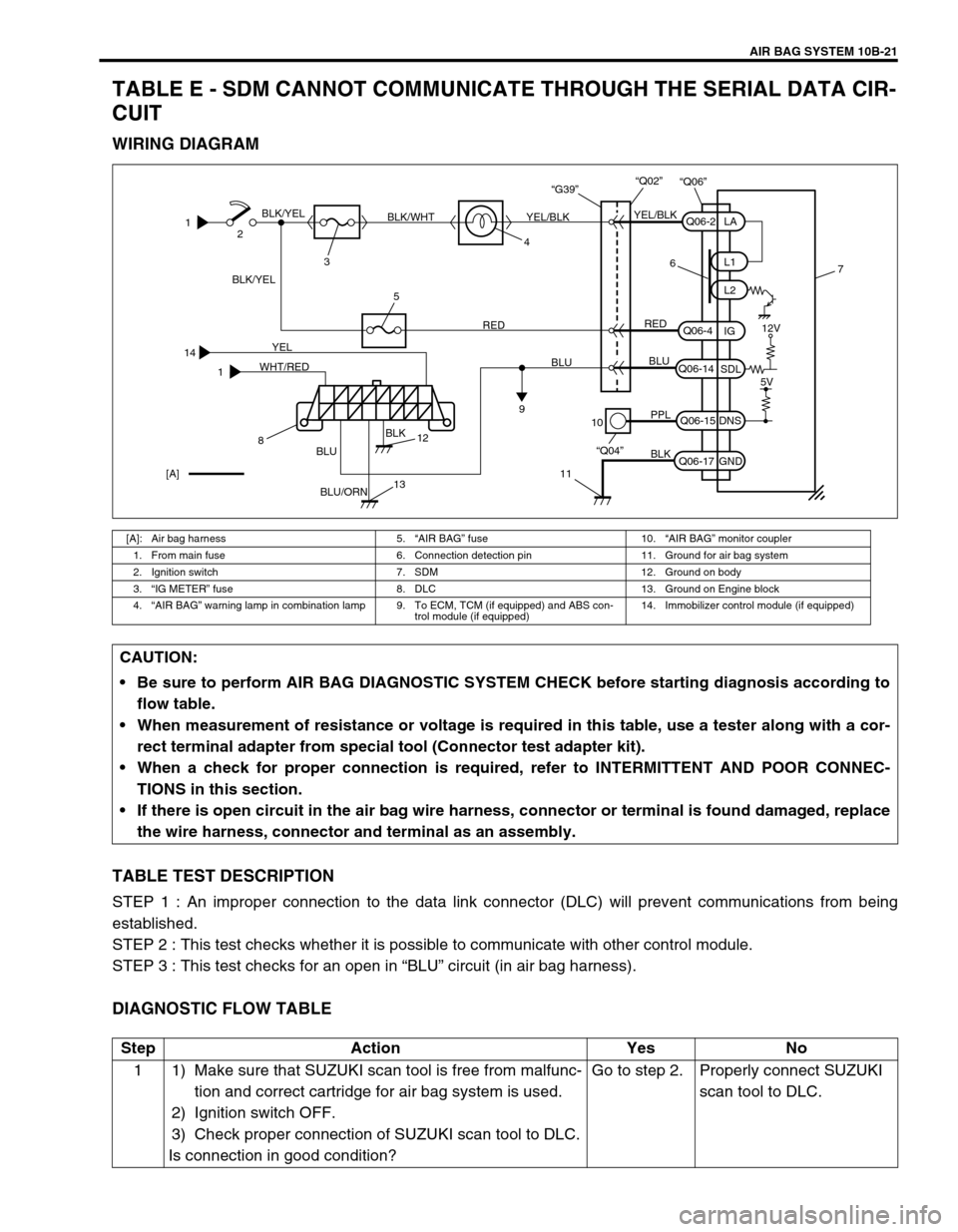immobilizer SUZUKI SWIFT 2000 1.G Transmission Service Owner's Manual
[x] Cancel search | Manufacturer: SUZUKI, Model Year: 2000, Model line: SWIFT, Model: SUZUKI SWIFT 2000 1.GPages: 447, PDF Size: 10.54 MB
Page 297 of 447

IMMOBILIZER CONTROL SYSTEM 8G-19
Fig. 1 for Step 1
Fig. 2 for Step 2NOTE:
After replacing with a known-good ECM, register ECM/Immobilizer Control Module code in ECM by
performing procedure described in “PROCEDURE AFTER ECM REPLACEMENT” in this section.
After replacing with a known-good Immobilizer Control Module, register ECM/Immobilizer Control
Module code in ECM and Transponder code and ECM/Immobilizer Control Module code in Immobi-
lizer Control Module by performing procedure described in “PROCEDURE AFTER IMMOBILIZER
CONTROL MODULE REPLACEMENT” in the section.
2. Connect to serial data link terminal (G02-7) of ECM coupler disconnected
Page 298 of 447

8G-20 IMMOBILIZER CONTROL SYSTEM
INSPECTION OF ECM, IMMOBILIZER CON-
TROL MODULE AND ITS CIRCUIT
ECM, Immobilizer Control Module and its circuit can be checked
at ECM wiring couplers and Immobilizer Control Module wiring
coupler by measuring voltage. Described here is only inspection
of Immobilizer Control Module. For inspection of ECM, refer to
“ENGINE & EMISSION CONTROL INPUT/OUTPUT TABLE” in
Section 6E1.
Voltage Check
1) Remove Immobilizer Control Module from steering lock
assembly with ignition switch OFF, referring to “REMOVAL”
of “IMMOBILIZER CONTROL MODULE” in this section.
2) Connect Immobilizer Control Module coupler to Immobilizer
Control Module.
3) Check voltage at each terminal of coupler connected.CAUTION:
Immobilizer Control Module cannot be checked by itself.
It is strictly prohibited to connect voltmeter or ohmmeter
to Immobilizer Control Module with coupler disconnected
from it.
NOTE:
As each terminal voltage is affected by the battery volt-
age, confirm that it is 11V or more when ignition switch is
ON.
1. Immobilizer Control Module
2. Immobilizer Control Module coupler
3. Body ground
TERMINAL CIRCUIT NOMAL VOLTAGE CONDITION
G06-1 Ground––
G06-2Data link connector
(Serial data terminal)4 – 5V Ignition switch ON
G06-3 Ignition signal10 – 14V Ignition switch ON
0 – 0.8V Ignition switch OFF
G06-4 Power source 10 – 14V Ignition switch ON
Page 299 of 447

IMMOBILIZER CONTROL SYSTEM 8G-21
ON-VEHICLE SERVICE
PRECAUTIONS IN HANDLING IMMOBILIZER
CONTROL SYSTEM
Don’t turn ON ignition switch with ignition key for immobilizer
control system put together with another one or placed quite
close to another one. Or the system may detect abnormal
condition and prevent engine from starting.
Do not turn ON ignition switch by using ignition key with any
type of metal wound around its grip or in contact with it. Or
the system may detect abnormal condition and prevent
engine from starting.
Do not leave ignition key where high temperature is antici-
pated.High temperature will cause transponder in ignition
key to be abnormal or damaged.
Page 300 of 447

8G-22 IMMOBILIZER CONTROL SYSTEM
Do not turn ON ignition switch with a radio antenna placed
near Immobilizer Control Module. Or the system may detect
abnormal condition and prevent engine from starting.
IMMOBILIZER CONTROL MODULE
REMOBAL
1) Disconnect negative (–) cable at battery.
2) Remove steering column upper and lower cover.
3) Disconnect coupler at Immobilizer Control Module.
4) Remove immobilizer control module (1) from steering lock
assembly (2) after removing instrument cluster panel.
INSTALLATION
Reverse removal procedure for installation.
NOTE:
If a screwdriver whose length is 40mm or less is used,
the immobilizer control module can be removed without
removing the instrument cluster panel.
NOTE:
After replacing Immobilizer Control Module, be sure to
register Transponder code and ECM/Immobilizer Control
Module code in Immobilizer Control Module and ECM/
Immobilizer Control Module code in ECM by performing
procedure described in “PROCEDURE AFTER IMMOBI-
LIZER CONTROL MODULE REPLACEMENT” in this sec-
tion.
Page 301 of 447

IMMOBILIZER CONTROL SYSTEM 8G-23
HOW TO REGISTER IGNITION KEY
Register the ignition key with a built-in transponder in Immobilizer
Control Module by using the following procedure.
1) Prepare SUZUKI scan tool and cartridge for immobilizer con-
trol system.
2) With ignition switch OFF, connect SUZUKI scan tool to data
link connector (DLC) (1) located on underside of instrument
panel at driver’s seat side.
(A) : 09931-76011 (SUZUKI scan tool)
(B) : Immobilizer cartridge
(C) : 09931-76030 (16/14 pin DLC cable)
3) Prepare ignition key with a built-in transponder (1). And then
turn ignition switch ON by using it.
4) Number of Transponder codes for ignition key with a built-in
transponder that can be registered in Immobilizer Control
Module is limited to 4. If needed, clear all Transponder
codes for ignition key with a built-in transponder that have
been registered in Immobilizer Control Module by executing
the “CLR. TRANS COD (CLEAR TP CODE)” command in
the SELECT MODE menu by using SUZUKI scan tool. CAUTION:
When registering the ignition key including a transpon-
der into the immobilizer control module by using Suzuki
scan tool, confirm that the knob color of the ignition key
to be registered for the vehicle is dark gray. The ignition
key with wrong knob color cannot be registered.
NOTE:
For operation procedure of SUZUKI scan tool, refer to
SUZUKI scan tool operator’s manual.
1
(C)(A)
(B)
NOTE:
When “CLR. TRANS COD (CLEAR TP CODE)” command
is executed with the immobilizer indicator lamp ON, it
remains ON even after execution of that command is
over. It will start flashing when the ignition switch is
turned OFF once and then turned ON after some sec-
onds.
Page 302 of 447

8G-24 IMMOBILIZER CONTROL SYSTEM
5) Using SUZUKI scan tool, register Transponder code in
Immobilizer Control Module by executing “ENT. TRANS
COD (ENT. TP CODE)” command in SELECT MODE menu.
6) Make sure that immobilizer indicator lamp lights when igni-
tion switch is turned OFF once and then ON.
7) If any other Transponder code for ignition key with a built-in
transponder needs to be registered, repeat above steps 3),
5) and 6).
PROCEDURE AFTER IMMOBILIZER CONTROL MODULE
REPLACEMENT
When Immobilizer Control Module was replaced, including when replaced because rechecking by using a
known-good Immobilizer Control Module was necessary during trouble diagnosis, register Transponder code
and ECM/Immobilizer Control Module code in Immobilizer Control Module and ECM/Immobilizer Control Module
code in ECM by performing following procedure.
1) Perform steps 1) and 2) described in “How To Register Ignition Key”.
2) Prepare ignition key with a built-in transponder. And then turn ignition switch ON by using it.
3) Using SUZUKI scan tool, clear all transponder codes registered in Immobilizer Control Module by executing
“CLR. TRANS COD (CLEAR TP CODE)” command in SELECT MODE menu.
4) Using SUZUKI scan tool, register Transponder code in Immobilizer Control Module by executing “ENT.
TRANS COD (ENT. TP CODE)” command in SELECT MODE menu.
5) Using SUZUKI scan tool, register ECM/Immobilizer Control Module code in both Immobilizer Control Module
and ECM by executing “RECORD ECU (RECORD ECM/PCM/ICM)” command in SELECT MODE menu.
6) Make sure that immobilizer indicator lamp lights when ignition switch is turned OFF once and then ON.
7) If any other Transponder code for ignition key with a built-in transponder needs to be registered, repeat
above steps 2), 4) and 6).NOTE:
Up to 4 Transponder codes for ignition key with a built-
in transponder can be registered.
It is not possible to register the same Transponder
code for ignition key with a built-in transponder as the
one already registered in Immobilizer Control Module.
CAUTION:
When registering the ignition key including a transponder into the immobilizer control module by
using Suzuki scan tool, confirm that the knob color of the ignition key to be registered for the vehicle
is dark gray. The ignition key with wrong knob color cannot be registered.
NOTE:
When “CLR. TRANS COD (CLEAR TP CODE)” command is executed with the immobilizer indicator
lamp ON, it remains ON even after execution of that command is over. It will start flashing when the
ignition switch is turned OFF once and then turned ON after some seconds.
Page 303 of 447

IMMOBILIZER CONTROL SYSTEM 8G-25
PROCEDURE AFTER ECM REPLACEMENT
When ECM was replaced, including when replaced because rechecking by using a known-good ECM was nec-
essary during trouble diagnosis, register ECM/Immobilizer Control Module code in ECM by performing following
procedure.
1) Perform steps 1) and 2) described in “How To Register Ignition Key”. And then turn ignition switch ON.
2) Using SUZUKI scan tool, register ECM/Immobilizer Control Module code in ECM by executing “RECORD
ECU (RECORD ECM/lCM)” command in SELECT MODE menu.
3) Make sure that malfunction indicator lamp lights when ignition switch is turned OFF once and then ON.
SPECIAL TOOL
NOTE:
Up to 4 Transponder codes for ignition key with a built-in transponder can be registered.
It is not possible to register the same Transponder code for ignition key with a built-in transponder
as the one already registered in Immobilizer Control Module.
NOTE:
For operation procedure of SUZUKI scan tool, refer to SUZUKI scan tool operator’s manual.
09931-76011 09931-76030
Tech 1A kit
See NOTE below.Immobilizer cartridge of
version 1.1 or more16/14 pin DLC cable Mass storage cartridge of
version 1.5 or more
NOTE:
This kit includs the following items.
1. Storage case, 2. Operator’s manual, 3. Tech 1A, 4. DLC cable, 5. Test lead/probe,
6. Power source cable, 7. DLC cable adaptor, 8. Self-test adaptor
Page 304 of 447

8G-26 IMMOBILIZER CONTROL SYSTEM
Page 395 of 447

AIR BAG SYSTEM 10B-21
TABLE E - SDM CANNOT COMMUNICATE THROUGH THE SERIAL DATA CIR-
CUIT
WIRING DIAGRAM
TABLE TEST DESCRIPTION
STEP 1 : An improper connection to the data link connector (DLC) will prevent communications from being
established.
STEP 2 : This test checks whether it is possible to communicate with other control module.
STEP 3 : This test checks for an open in “BLU” circuit (in air bag harness).
DIAGNOSTIC FLOW TABLE
[A]: Air bag harness 5.“AIR BAG” fuse 10.“AIR BAG” monitor coupler
1. From main fuse 6. Connection detection pin 11. Ground for air bag system
2. Ignition switch 7. SDM 12. Ground on body
3.“IG METER” fuse 8. DLC 13. Ground on Engine block
4.“AIR BAG” warning lamp in combination lamp 9. To ECM, TCM (if equipped) and ABS con-
trol module (if equipped)14. Immobilizer control module (if equipped)
1
14
12
34 BLK/YEL
BLK/YEL
YELBLK/WHT
BLK
BLU/ORNYEL/BLKYEL/BLK
6
RED
WHT/REDRED
BLU
BLU
BLU
5
9
10
11
PPL
BLK
“Q04”“Q06”
Q06-2
Q06-4
Q06-14
Q06-15
Q06-17L1
L2
IG
SDL
DNS
GNDLA
7
[A]
12V
5V
“G39”“Q02”
812
13
CAUTION:
Be sure to perform AIR BAG DIAGNOSTIC SYSTEM CHECK before starting diagnosis according to
flow table.
When measurement of resistance or voltage is required in this table, use a tester along with a cor-
rect terminal adapter from special tool (Connector test adapter kit).
When a check for proper connection is required, refer to INTERMITTENT AND POOR CONNEC-
TIONS in this section.
If there is open circuit in the air bag wire harness, connector or terminal is found damaged, replace
the wire harness, connector and terminal as an assembly.
Step Action Yes No
1 1) Make sure that SUZUKI scan tool is free from malfunc-
tion and correct cartridge for air bag system is used.
2) Ignition switch OFF.
3) Check proper connection of SUZUKI scan tool to DLC.
Is connection in good condition?Go to step 2. Properly connect SUZUKI
scan tool to DLC.